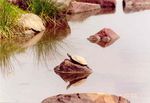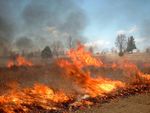Managing a Pond for Wildlife - Audubon International
←
→
Page content transcription
If your browser does not render page correctly, please read the page content below
Managing a Pond for Wildlife
There are a number of things you can do to maximize the habitat
potential of a pond, no matter what its size. A pond’s attractiveness
to wildlife is largely dependent upon the number and variety of
aquatic and shoreline plants surrounding it. While you may be
familiar with planting trees, shrubs, or flowers on your property to
attract wildlife, planting a pond requires special consideration and
generally presents even experienced gardeners with unique
challenges.
Create a Balanced Pond Ecology
A pond’s natural aging process, known as succession, refers to the
transition from open water to marsh and, ultimately, upland that Birds and mammals rely on ponds to drink, bathe, and
slowly occurs over many years. Nutrients introduced into a cool off, while numerous species of fish, salamanders,
frogs, and aquatic insects live or fulfill vital aspects of
waterway can greatly accelerate plant growth, speed natural their life cycle in the water. If you have a pond on your
succession, and create an unhealthy pond ecosystem. property or are thinking about installing one, consider
turning it into a haven for wildlife.
A combination of sunlight, warm temperatures, and phosphorous
promotes plant growth. If nutrient-rich surface water drains directly into water bodies, excessive growth of
aquatic plants and algae is stimulated. The resulting murky-green water is not only unattractive, but too much
algae depletes the oxygen in the water, adversely affecting fish and other aquatic creatures. Unfortunately, the
perception that all pond vegetation is unwanted often results.
Aquatic plants play an important role in the health of a pond and have many positive attributes such as
producing oxygen to aerate the water and supplying food for aquatic organisms. They also provide shelter and
a spawning medium for fish and freshwater invertebrates. Plants provide nesting sites and food for water fowl
as well as filter pollutants and nutrients. In addition to these things, plants provide aesthetic appeal.
Eliminating Nutrient Loading
To create a balanced pond ecology, it is essential to eliminate nutrient loading to ponds. A careful review of
maintenance practices is a good place to start. Spring fertilization programs are a common culprit of pond
problems since these nutrient applications coincide with warmer temperatures and increasing sunlight.
Several simple practices can help to minimize runoff.
Buffers: Vegetation such as taller grasses, emergent plants, and shrubs serve as effective buffers,
and they provide additional value as food and cover sources for wildlife. A vegetative buffer
surrounding all sides of the pond would provide the best nutrient filter. A filter, such as a swale, around
the receiving edge of the pond will intercept surface flow and help to reduce the nutrient load.
No-Spray Zones: Designating a zone around the pond in which no chemicals will be used eliminates
runoff from the immediate surrounding area and decreases drift that may enter the water.
To download this fact sheet and more, visit: www.auduboninternational.org Slow-Release Fertilizers: These products have less potential
for leaching since they release fertilizers more slowly.
Floating Plants: Plants such as water lilies can be installed to
shade the water surface, thus reducing sunlight and water
temperature. The leaves of a single, mature water lily can cover
an area of eight square feet or more. Small-leaved species can
be used in smaller pools. Planting overhanging vegetation along
pond margins can have the same effect.
Aerators: The amount of oxygen in the water can be increased
by using oxygenating plants such as water celery and coontail or The leaf of a water lily not only reduces the
by installing oxygen diffusers or waterfalls which aerate the amount of penetrable sunlight in a pond resulting
in lower water temperatures, but numerous
water. This promotes healthy fish populations which will feed on aquatic insects also utilize the leaf to lay their
algae and insect larvae and help control mosquitoes. eggs.
Filters: Pond filters rid the water of algae and debris, thus
promoting a cleaner pond environment.
Enhancing a Pond
Depending on the size and planned usage of the pond, different ways can be used to enhance a pond for
aesthetic value as well as for wildlife. Planting in small portions will allow you to get a feel for what you want
in and around your pond.
Existing Vegetation: Take stock of the existing plants in and around your pond. This will give you
valuable information about what types of plants seem to grow well. In some cases, you may choose to
expand existing natural areas or add to their diversity by introducing different types of shoreline plants.
Sunlight and Water Depth: Use a yardstick to measure the depth to the bottom along the edge of the
pond. Also note how many hours of sun the pond receives each day. Knowing this information will
help you to decide what plants will grow best in and around the pond. For example, many aquatic
plants, including pond lilies, prefer full sun, while others, such as tall scouring-rush, can tolerate
shade. Aquatic plants are also adapted to survive at varying water depths. Emergent plants, including
arrowheads, bulrushes, and rice cutgrass need to be planted in the water to survive. Others prefer to
be along the edge of the pond and can only tolerate moist soil, not inundation.
Wildlife Value and Aesthetics: Other factors to consider
when choosing aquatic plants include their wildlife and
aesthetics value. While certain plants provide both food and
cover, many offer only one or the other. Choosing native plants
with a high wildlife value will help you to attract the greatest
diversity of species. At the same time, you may also want to
choose a few plants simply for their aesthetic value. For
example, blue flag iris and marsh marigold offer limited food
and cover, but a small clump can provide beautiful ornamental
interest along the shoreline of your pond.
Rocks and Logs: Adding rocks and logs provides islands and
shallow water areas. These will be used for protection and
nesting sites by small creatures and serve as basking sites for
Where upland shorelines cannot be naturalized,
planting aquatic vegetation in shallow areas can turtles. Sinking a tree can provide shelter for fish.
greatly enhance a pond for wildlife.
To download this fact sheet and more, visit: www.auduboninternational.orgControlling Aquatic Plants
Sometimes plants can become too numerous or invasive species
take over the natural plant-life. Eliminating nutrient loading will help
prevent this, but if it has happened there are many ways to control
plants.
Physical Removal: The least harmful of methods is to
manually or mechanically remove unwanted plants. Many
rooted aquatic plants can be pulled while floating plants and
algae can be raked or skimmed off. Physical removal has the
added benefit of “harvesting” nutrients from the pond.
Manual removal of algae and aquatic weeds helps
Bottom Barriers: Plastic, rubber, or fiberglass can be used to remove nutrients from the pond.
to inhibit or prevent rooted growth in selected areas.
Shading: Floating vegetation, overhanging plants, shrubs, and trees, and/or artificial structures can
be used to shade out aquatic plant growth. Soluble dyes have little effect on shallow ponds as they do
not prevent the sunlight from reaching the bottom.
Drawdown/Dredging: Periodic lowering of water levels will expose bottom sediments and allow some
plants to be dried out, frozen, and/or removed.
Biological Controls: Fish such as grass carp or white amur can be introduced to eat certain plant
material. Insects such as moth larvae or weevils can be used to selectively eat water hyacinth and
alligator weed. Introduction of pathogens such as bacteria, viruses, fungi, or other micro-organisms
has been used. These methods should be restricted to water features that are not connected to other
water bodies.
Chemical Controls: There are many chemical products on the market and are the most common
strategy for controlling plants. However, chemical management often treats the symptom and not the
cause of weed and algae problems. Chemicals can do more damage than good, compound the
problem, and harm desired plants and animals. Chemical controls should be a last resort and great
care should be taken in their application.
Controlled or Prescribed Burns: Controlled burns can kill or
set back certain invasive species that do not tolerate fire, but
burning is only effective if done a few years in a row for many
species. Otherwise, it could result in invasives returning with
more vigor. Burning is a dangerous activity that requires
planning, coordination, equipment, and trained personnel, and
should not be taken lightly. More information on burning can be
found at:
http://wiki.bugwood.org/Invasipedia
http://www.invasive.org/gist/control.html
http://www.imapinvasives.org/GIST/ESA/index.html The effectiveness of control burns depends on
the targeted species, fuel type, and associated
risks.
To download this fact sheet and more, visit: www.auduboninternational.orgEnhancement for Water Birds
Loss and destruction of water bird habitat is a critical problem facing
water bird populations. Pollution and development in wetland areas
has had severe consequences for many species of wading birds.
Protecting breeding and critical migration habitat must be a priority for
ensuring water bird survival. In the course of managing a pond, some
steps already mentioned, such as providing plants for food and cover,
help to ensure habitat for water birds. The following are some special
concerns:
A pond or marsh created for water birds should have a gentle
slope and water depth of no greater than 18” deep. Most birds
can’t feed in water of greater depth. Ponds with steep banks Turtles use rocks or fallen tree limbs to bask in the
also inhibit vegetative growth that provides nesting areas and sun.
food.
Keep the water level of a pond stable to encourage the growth of aquatic vegetation.
Fence edges of ponds with sensitive nesting areas or vegetation to keep people from trampling these
valuable habitats.
Do not let ponds or marshes be drained for repair or other purposes during important migration times
(early winter) or the breeding season (spring).
Provide resting sites for water birds, such as bare spots on the shore, floating logs, rafts, or islands.
To download this fact sheet and more, visit: www.auduboninternational.orgYou can also read























































